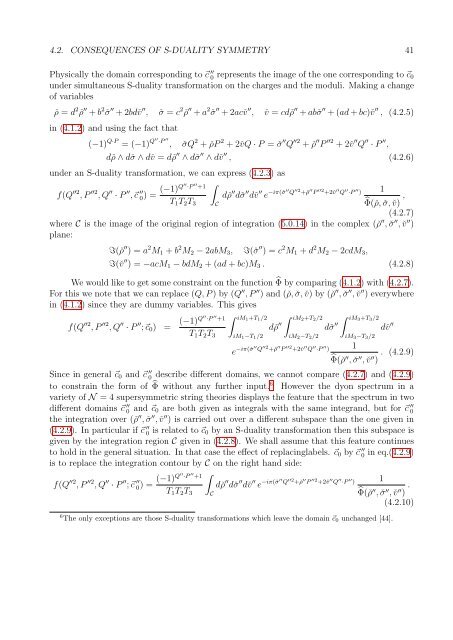PHYS08200604018 Shamik Banerjee - Homi Bhabha National ...
PHYS08200604018 Shamik Banerjee - Homi Bhabha National ...
PHYS08200604018 Shamik Banerjee - Homi Bhabha National ...
You also want an ePaper? Increase the reach of your titles
YUMPU automatically turns print PDFs into web optimized ePapers that Google loves.
4.2. CONSEQUENCES OF S-DUALITY SYMMETRY 41<br />
Physically the domain corresponding to ⃗c ′′<br />
0 represents the image of the one corresponding to ⃗c 0<br />
under simultaneous S-duality transformation on the charges and the moduli. Making a change<br />
of variables<br />
ˇρ = d 2 ˇρ ′′ + b 2ˇσ ′′ + 2bdˇv ′′ , ˇσ = c 2 ˇρ ′′ + a 2ˇσ ′′ + 2acˇv ′′ , ˇv = cdˇρ ′′ + abˇσ ′′ + (ad + bc)ˇv ′′ , (4.2.5)<br />
in (4.1.2) and using the fact that<br />
(−1) Q·P = (−1) Q′′·P ′′ , ˇσQ 2 + ˇρP 2 + 2ˇvQ · P = ˇσ ′′ Q ′′2 + ˇρ ′′ P ′′2 + 2ˇv ′′ Q ′′ · P ′′ ,<br />
dˇρ ∧ dˇσ ∧ dˇv = dˇρ ′′ ∧ dˇσ ′′ ∧ dˇv ′′ , (4.2.6)<br />
under an S-duality transformation, we can express (4.2.3) as<br />
f(Q ′′2 , P ′′2 , Q ′′ · P ′′ ,⃗c ′′<br />
0) = (−1)Q′′·P ′′ +1<br />
T 1 T 2 T 3<br />
∫C<br />
dˇρ ′′ dˇσ ′′ dˇv ′′ e −iπ(ˇσ′′ Q ′′2 +ˇρ ′′ P ′′2 +2ˇv ′′ Q ′′·P ′′ ) 1<br />
̂Φ(ˇρ, ˇσ, ˇv) ,<br />
(4.2.7)<br />
where C is the image of the original region of integration (5.0.14) in the complex (ˇρ ′′ , ˇσ ′′ , ˇv ′′ )<br />
plane:<br />
I(ˇρ ′′ ) = a 2 M 1 + b 2 M 2 − 2abM 3 , I(ˇσ ′′ ) = c 2 M 1 + d 2 M 2 − 2cdM 3 ,<br />
I(ˇv ′′ ) = −acM 1 − bdM 2 + (ad + bc)M 3 . (4.2.8)<br />
We would like to get some constraint on the function ̂Φ by comparing (4.1.2) with (4.2.7).<br />
For this we note that we can replace (Q, P ) by (Q ′′ , P ′′ ) and (ˇρ, ˇσ, ˇv) by (ˇρ ′′ , ˇσ ′′ , ˇv ′′ ) everywhere<br />
in (4.1.2) since they are dummy variables. This gives<br />
f(Q ′′2 , P ′′2 , Q ′′ · P ′′ (−1)Q′′·P ′′ +1<br />
∫ iM1 +T 1 /2 ∫ iM2 +T 2 /2 ∫ iM3 +T 3 /2<br />
;⃗c 0 ) = dˇρ ′′ dˇσ ′′ dˇv ′′<br />
T 1 T 2 T 3<br />
iM 1 −T 1 /2<br />
iM 2 −T 2 /2<br />
iM 3 −T 3 /2<br />
e −iπ(ˇσ′′ Q ′′2 +ˇρ ′′ P ′′2 +2ˇv ′′ Q ′′·P ′′ ) 1<br />
̂Φ(ˇρ ′′ , ˇσ ′′ , ˇv ′′ ) . (4.2.9)<br />
Since in general ⃗c 0 and ⃗c ′′<br />
0 describe different domains, we cannot compare (4.2.7) and (4.2.9)<br />
to constrain the form of ̂Φ without any further input. 6 However the dyon spectrum in a<br />
variety of N = 4 supersymmetric string theories displays the feature that the spectrum in two<br />
different domains ⃗c ′′<br />
0 and ⃗c 0 are both given as integrals with the same integrand, but for ⃗c ′′<br />
0<br />
the integration over (ˇρ ′′ , ˇσ ′′ , ˇv ′′ ) is carried out over a different subspace than the one given in<br />
(4.2.9). In particular if ⃗c ′′<br />
0 is related to ⃗c 0 by an S-duality transformation then this subspace is<br />
given by the integration region C given in (4.2.8). We shall assume that this feature continues<br />
to hold in the general situation. In that case the effect of replacinglabels. ⃗c 0 by ⃗c ′′<br />
0 in eq.(4.2.9)<br />
is to replace the integration contour by C on the right hand side:<br />
f(Q ′′2 , P ′′2 , Q ′′ · P ′′ ;⃗c ′′ (−1)Q′′·P ′′ +1<br />
0) = dˇρ<br />
T 1 T 2 T 3<br />
∫C<br />
′′ dˇσ ′′ dˇv ′′ e −iπ(ˇσ′′ Q ′′2 +ˇρ ′′ P ′′2 +2ˇv ′′ Q ′′·P ′′ ) 1<br />
̂Φ(ˇρ ′′ , ˇσ ′′ , ˇv ′′ ) .<br />
(4.2.10)<br />
6 The only exceptions are those S-duality transformations which leave the domain ⃗c 0 unchanged [44].

















